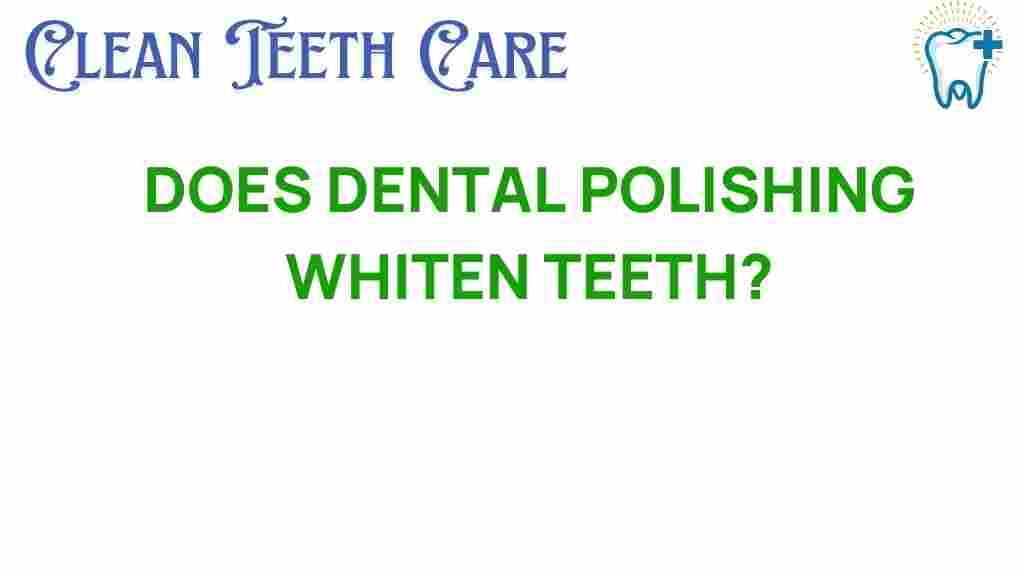Does Dental Polishing Really Whiten Your Teeth?
When it comes to achieving a brighter, more radiant smile, many people turn to various dental treatments. One common procedure that often comes up is dental polishing. But does it actually contribute to teeth whitening, or is it merely a cosmetic enhancement? In this article, we will explore the relationship between dental polishing and teeth whitening, while also discussing its role in oral hygiene and overall cosmetic dentistry.
Understanding Dental Polishing
Dental polishing is a procedure typically performed during a professional dental cleaning. It involves using a rubber cup and a special polishing paste to remove plaque, stains, and other debris from the surface of the teeth. This treatment can leave your teeth feeling smooth and looking shiny, but how effective is it in terms of whitening?
The Science Behind Teeth Whitening
Teeth whitening is a process that aims to lighten the color of your teeth, making them appear whiter and brighter. There are several methods available for whitening, including:
- In-office whitening treatments: These are professional procedures conducted by dentists, utilizing stronger bleaching agents for immediate results.
- At-home whitening kits: These products usually contain lower concentrations of bleaching agents and are used over a period of time.
- Whitening toothpaste: These contain mild abrasives and chemicals that can help remove surface stains but do not change the natural color of teeth.
While dental polishing can remove surface stains, it does not change the intrinsic color of the teeth. Therefore, it is essential to understand the limitations of this procedure when considering smile enhancement.
The Role of Dental Polishing in Oral Hygiene
Dental polishing plays a significant role in maintaining good oral hygiene. Here’s how:
- Removal of Plaque: Polishing helps in the effective removal of plaque that may not be eliminated during regular brushing and flossing.
- Stain Reduction: It can reduce the appearance of stains caused by food, drinks, and tobacco, leading to a cleaner appearance.
- Enamel Care: Professional polishing can help maintain enamel health by providing a smoother surface that is less prone to plaque accumulation.
Dental Treatments and Their Impact on Smile Enhancement
While dental polishing is beneficial for maintaining oral hygiene, it should be viewed as part of a broader dental treatment plan. Other cosmetic procedures that contribute to smile enhancement include:
- Veneers: Thin shells of porcelain or composite resin that cover the front surface of teeth to improve their appearance.
- Bonding: A tooth-colored resin applied to teeth to correct imperfections, gaps, or discoloration.
- Whitening treatments: As discussed earlier, these treatments can effectively lighten teeth beyond what polishing can achieve.
For those looking for a more dramatic change in their smile, consulting with a cosmetic dentist is advisable. They can recommend the best combination of treatments tailored to individual needs.
Step-by-Step Process of Dental Polishing
The dental polishing process is generally straightforward and can be broken down into a few key steps:
- Initial Examination: Your dentist will examine your teeth and gums to assess your oral health and determine if dental polishing is suitable for you.
- Professional Cleaning: A thorough cleaning will be performed to remove any tartar and plaque buildup.
- Polishing Procedure: A rubber cup is attached to a handpiece, and a polishing paste is applied to each tooth, buffing them to a shine.
- Fluoride Treatment: After polishing, a fluoride treatment may be applied to strengthen enamel and protect against cavities.
Troubleshooting Tips for Post-Polishing Care
After your dental polishing session, it’s essential to care for your teeth properly to maintain their appearance and health. Here are some tips:
- Avoid Staining Foods: Immediately after polishing, try to avoid foods and drinks that can stain your teeth, such as coffee, tea, and red wine.
- Maintain Oral Hygiene: Continue brushing and flossing regularly to keep your teeth clean and prevent plaque buildup.
- Use Whitening Toothpaste: Consider using a whitening toothpaste to help remove any surface stains that may develop.
Combining Dental Polishing with Other Treatments
If you’re looking for significant whitening results, combining dental polishing with other dental treatments may be beneficial. Here are some strategies:
- Schedule Regular Cleanings: Regular professional cleanings and polishing can help maintain a bright smile.
- Consider At-Home Whitening: Use at-home whitening kits in conjunction with polishing for enhanced results.
- Consult with a Cosmetic Dentist: Discuss your goals with a cosmetic dentist who can provide a personalized treatment plan.
When to Consider Professional Polishing
While dental polishing is an excellent option for many, it may not be necessary for everyone. Consider professional polishing if you:
- Have not had a dental cleaning in over six months.
- Experience a buildup of plaque or tartar.
- Are concerned about surface stains from foods or beverages.
- Want to maintain your oral hygiene routine effectively.
Final Thoughts on Dental Polishing and Teeth Whitening
In conclusion, dental polishing can enhance your smile by removing surface stains and promoting better oral hygiene. However, it should not be confused with true teeth whitening, which involves changing the color of the teeth themselves. For optimal results, consider incorporating dental polishing with other dental treatments and regular maintenance practices. Always consult with your dentist to determine the best approach for your unique smile needs.
For more information on enhancing your smile and maintaining oral health, check out this comprehensive guide on oral hygiene. And remember, achieving a dazzling smile often requires a combination of treatments and diligent care.
If you’re interested in professional whitening options, visit this external resource on teeth whitening to learn more about what might be right for you.
This article is in the category Treatments and created by CleanTeethCare Team
